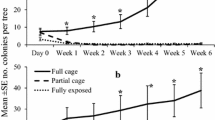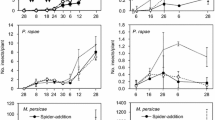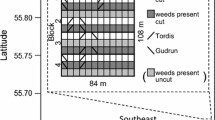Summary
Since the early 1980s, the winter moth, Operophtera brumata L. (Lepidoptera: Geometridae) has emerged as a serious pest of Sitka Spruce, Picea sitchensis Bong. plantations in southern Scotland. Outbreaks are characterised by susceptible sites within plantations which can occur immediately adjacent to resistant sites. We investigated the level of some nutrients in the trees, the date of budburst of the trees, and the numbers of some potential predators of winter moth pupae. None could satisfactorily explain outbreak patterns. Although foliage analysis demonstrated that many trees were marginal or deficient in phosphorus, nitrogen and potassium, these deficiencies were not related to the susceptibility of a site. Within sites, the numbers and weights of O. brumata were positively related to phosphorus content and negatively related to calcium content of foliage. Other evidence suggests, however, that these correlations may not represent direct effects of phosphorus and calcium on larval growth and survival. Date of budburst, which commonly determines susceptibility of deciduous hosts to O. brumata, was unrelated to density, and pupal predators were more, not less, abundant in susceptible sites. Although it is difficult to distinguish between factors that initiate outbreaks and those that maintain them, these data suggest that nutrient deficiencies of trees, budburst date, and the distribution of pupal predators of the winter moth cannot explain patterns of outbreak of the winter moth on spruce.
Similar content being viewed by others
References
Avery BW (1973) Soil classification in the soil survey of England and Wales. J Soil Science 24:324–338
Bejer P (1985) Nun moth (Lymantria monacha L.) outbreaks in Denmark and their association with site factors and climate. In: D Bevan, and JT Stoakley (eds) Site Characteristics and population dynamics of Lepidopteran and Hymenopteran forest pests. Forestry Commission R and D p 135
Bevan D, Stoakley JT (1985) Site characteristics and population dynamics of Lepdopteran and Hymenopteran forest pests. Forestry Commission R and D p 135
Crawley MJ (1983) Herbivory, the dynamics of animal-plant interactions. Blackwell, Oxford
De Bolt DC (1980) Multielement emmission spectroscopic analysis of plant tissue using de argon plasma source. J Assoc Off Anal Chem 63:802–805
Embree DG (1965) The population dynamics of the winter moth in Nova Scotia, 1954–1962. Memoirs Entomol Soc Can 46:1–57
Feeny P (1970) Seasonal changes in oak leaf tannins and nutrients as a cause of spring feeding by winter moth caterpillars. Ecology 51:565–581
Hanski I, Otronen M (1985) Food quality induced variance in larval performance: comparison between rare and common pine feeding sawflies (Diprionidae). Oikos 44:165–174
Holliday NJ (1975) The ecology and behaviour of winter moth in a cider apple orchard. Ph. D. Thesis, Bristol University
Hunter MD (1987) Opposing effects of spring defoliation on late season oak caterpillars. Ecol Entomol 12:373–382
Hunter MD (1990) Differential susceptibility to variable plant phenology and its role in competition between two insect herbivores on oak. Ecol Entomol 15:401–408
Hunter MD, West C (1990) Variation in the effects of spring defoliation on the late season phytophagous insects of Quercus robur. In: AD Watt, SR Leather, MD Hunter, NAC Kidd (eds) Population Dynamics of Forest Insects. Intercept Ltd, Andover
Hunter MD, Willmer PG (1989) The potential for interspecific competition between two abundant defoliators on oak: Leaf damage and habitat quality. Ecol Entomol 14:267–277
Larsson (1989) Stressful times for the plant stress-insect performance hypothesis. Oikos 56:277–283
Larsson S, Tenow O (1984) Areal distribution of a Neodiprion sertifer (Hym; Diprionidae) outbreak on Scots pine related to stand condition. Hol Ecol 7:81–90
Major EJ (1990) Water stress in Sitka Spruce and its effect on the green spruce aphid Elatobium abietinum. In: Watt AD, Leather SR, Hunter MD, Kidd NAC (eds) Population Dynamics of Forest Insects. Intercept Ltd, Andover
Price PW, Bouton CE, Gross P, McPheron BA, Thompson JN, Weis AE (1980) Interactions among three trophic levels: influence of plants on interactions between insect herbivores and natural enemies. Ann Rev Ecol Syst 11:41–65
Ramachandran R (1987) Influence of host plants on the wind dispersal and the survival of an Australian geometrid caterpillar. Ent Exp Appl 44:289–294
Renaud PE, Hay ME, Schmitt TM (1990) Interactions of plant stress and herbivory: Intraspecific variation in susceptibility of a palatable versus an unpalatable seaweed to sea urchin grazing. Oecologia (Berlin) 82:217–226
Roland J (1990) Interaction of parasitism and predation in the decline of winter moth in Canada. In: Watt AD, Leather SR, Hunter MD, Kidd NAC (eds) Population Dynamics of Forest Insects. Intercept Ltd, Andover
SAS Institute Inc (1985) SAS User's Guide: Statistics. Cary, NC
Savill PS, Evans J (1986) Plantation silviculture in temperate regions with special reference to the British Isles. Clarendon Press, Oxford
Schultz JC, Baldwin IT (1982) Oak leaf quality declines in response to defoliation by gypsy moth larvae. Science 217:149–151
Schultz JC, Foster MA, Montgomery ME (1990) Hostplantmediated impacts of a baculovirus on gypsy moth populations. In: Watt AD, Leather SR, Hunter MD, Kidd NAC (eds) Population Dynamics of Forest Insects. Intercept Ltd, Andover
Speight MR, Wainhouse D (1989) Ecology and management of forest insects. Clarendon Press, Oxford
Stoakley JT (1985) Outbreaks of winter moth, Operophtera brumata L. (Lep., Geometridae) in young plantations of Sitka spruce in Scotland. Z Ang Ent 99:153–160
Taylor RAJ (1980) A family of regression equations describing the density distribution of dispersing organisims. Nature 286:53–55
Tenow O (1972) The outbreaks of Oporinia autumnata Bleh. and Operophtera Spp. (Lepidoptera: Geometridae) in the Scandanavian mountain chain and northern Finland, 1862–1968. Zool Bid f Uppsala [S] 2:1–107
Varley GC, Gradwell GR (1968) Population models for the winter moth. In: TRE Southwood (ed) Insect Abundance. Symp Royal Ent Soc London 4:132–142
Walsh PJ (1990) Site factor, predators and pine beauty moth mortality. In: Watt AD, Leather SR, Hunter MD, Kidd NAC (eds) Population Dynamics of Forest Insects. Intercept Ltd, Andover
Watt AD (1986) The performance of the pine beauty moth on water-stressed lodgepole pine plants: a laboratory experiment. Oecologia 70:578–579
Watt AD (1988) Effect of stress-induced changes in plant quality and host-plant species on the population dynamics of the pine beauty moth in Scotland: partial life table analysis of natural and manipulated populations. J Appl Ecol 25:209–222
Watt AD, Leather SR, Hunter MD, Kidd NAC (1990) Population Dynamics of Forest Insects. Intercept Ltd, Andover
Watt AD, Leather SR, Stoakley JT (1989) Site susceptibility, population development and dispersal of the pine beauty moth in a lodgepole pine forest in northern Scotland. J Appl Ecol 26:147–157
West C (1985) Factors underlying the late seasonal appearance of the lepidopterous leaf mining guild on oak. Ecol Entomol 10:111–120
White TCR (1974) A hypothesis to explain outbreaks of looper caterpillars, with special reference to populations of Selidosema suavis in a plantation of Pinus radiata in New Zealand. Oecologia 16:279–301
White TCR (1984) The abundance of vertebrate herbivores in relation to the availibility of nitrogen in stressed food plants. Oecologia 63:90–105
Wint GRW (1983) Leaf damage in tropical rain forest canopies. In: Sutton SL, Whitmore C, Chadwick AC (eds) Tropical rainforest ecology and management. Special Report of the British Ecological Society. Blackwells, Oxford
Youngberg CT (1984) Soil and tissue analysis: tools for maintaining soil fertility. In: Duryea ML, Landis TD (eds) Forest Nursery Manual. Martinus Nijhoff/W Junk, The Hague
Author information
Authors and Affiliations
Rights and permissions
About this article
Cite this article
Hunter, M.D., Watt, A.D. & Docherty, M. Outbreaks of the winter moth on Sitka Spruce in Scotland are not influenced by nutrient deficiencies of trees, tree budburst, or pupal predation. Oecologia 86, 62–69 (1991). https://doi.org/10.1007/BF00317390
Received:
Accepted:
Issue Date:
DOI: https://doi.org/10.1007/BF00317390




